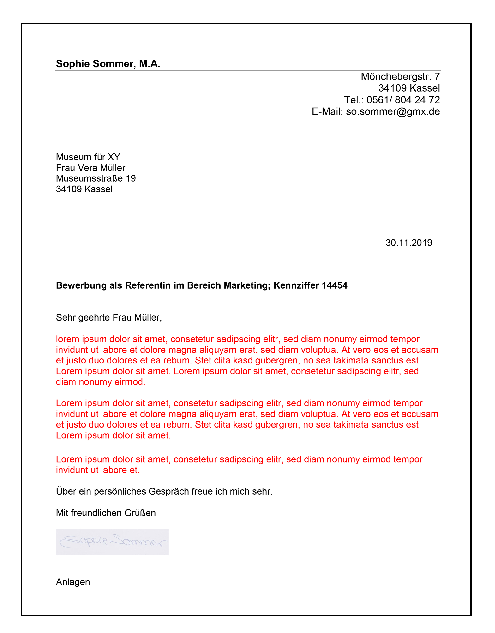Cover Letter
Formal structure
From a formal point of view, a cover letter is a business letter with which you present your request. The Din 5008 standard specifies the correct structure.
The salutation "Dear Sir or Madam" is out! You should use the name of the contact person, especially if this person is listed in the job advertisement. If it is not there, you can often find the name on the homepage of the work/internship employer. You can call the information desk of the institution or company to be addressed to ask for the name of the person responsible for personnel.
Also, have a simple-sounding name of the contact:in spelled out for you. This will help you avoid embarrassing mistakes: Mayer, Meier or Meyer? The first word after the salutation is written in lower case. The correct form of address is: Dear Ms. Meyer, thank you...
For example, the "GmbH" or "AG" must not be forgotten in the cover letter. The company spelling using upper and lower case letters must be observed. Tip: Adopt the designation in the imprint on the homepage if this information is not clear from the advertisement.
The subject line is displayed in bold. It must not be forgotten. Obsolete terms such as "Ref.:", "Subject" or "Ref.:", "Reference:" before the content "Application as..." are no longer used in the cover letter.
Cover letter and resume should be written uniformly in the same font and font size. Only the personal letterhead may deviate from this. Font size 12 is recommended; all legible types such as Arial, Times New Roman or Calibri are suitable as fonts.
On the lower left margin, list the word attachments. The word is neither bolded nor underlined. The individual attachments are not listed.
In address line, subject line or text, underlining is generally not used in the cover letter.
The correct number of spaces in the text must be observed. MS-Word has the "show/hide all formatting characters" button for checking.
Formulation tips for the cover letter
Example - Cover letter
Here you will find a sample cover letter. The text marked in red must be adjusted from place to place. The length shows a realistic picture.

